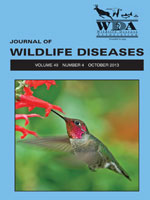Congenital toxoplasmosis has been little described in wild animals. We report a case of vertical transmission in wild boar (Sus scrofa). Necropsy and histopathologic examination of a pregnant female and her three fetuses revealed all to have lesions compatible with acute toxoplasmosis. Nested polymerase chain reaction B1 gene detected Toxoplasma gondii in maternal (heart and diaphragm) and fetal (central nervous system, retina, optic nerve, heart, lung, tongue, and diaphragm) samples. The mother had a mixed infection of T. gondii types I and III. One fetus with type III infection developed no malformations, but the others—one with type I infection and one infected by types I and III—showed bilateral ocular agenesis, prognathism, and agenesis of the nasal cartilage. These results suggest the pathogenicity of the various T. gondii types may differ in wild boars.
How to translate text using browser tools
1 October 2013
Congenital Toxoplasmosis in Wild Boar (Sus scrofa) and Identification of the Toxoplasma gondii Types Involved
Rafael Calero-Bernal,
Luis Gómez-Gordo,
José María Saugar,
Eva Frontera,
Juan Enrique Pérez-Martín,
David Reina,
Francisco Javier Serrano,
Isabel Fuentes
ACCESS THE FULL ARTICLE

Journal of Wildlife Diseases
Vol. 49 • No. 4
October 2013
Vol. 49 • No. 4
October 2013
congenital
genetic characterisation
Toxoplasma gondii
vertical transmission
wild boar




